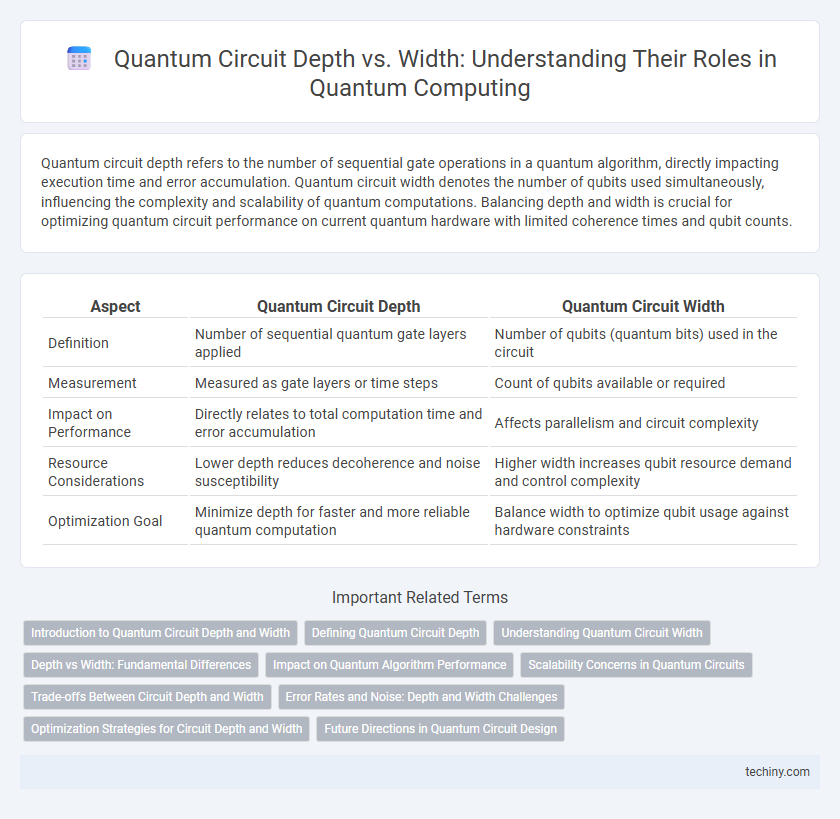Quantum circuit depth refers to the number of sequential gate operations in a quantum algorithm, directly impacting execution time and error accumulation. Quantum circuit width denotes the number of qubits used simultaneously, influencing the complexity and scalability of quantum computations. Balancing depth and width is crucial for optimizing quantum circuit performance on current quantum hardware with limited coherence times and qubit counts.
Table of Comparison
| Aspect | Quantum Circuit Depth | Quantum Circuit Width |
|---|---|---|
| Definition | Number of sequential quantum gate layers applied | Number of qubits (quantum bits) used in the circuit |
| Measurement | Measured as gate layers or time steps | Count of qubits available or required |
| Impact on Performance | Directly relates to total computation time and error accumulation | Affects parallelism and circuit complexity |
| Resource Considerations | Lower depth reduces decoherence and noise susceptibility | Higher width increases qubit resource demand and control complexity |
| Optimization Goal | Minimize depth for faster and more reliable quantum computation | Balance width to optimize qubit usage against hardware constraints |
Introduction to Quantum Circuit Depth and Width
Quantum circuit depth refers to the number of sequential operations or layers in a quantum circuit, impacting the overall computation time and error accumulation. Quantum circuit width denotes the number of qubits involved in the computation, influencing the level of parallelism and resource requirements. Understanding the balance between circuit depth and width is essential for optimizing quantum algorithm performance and hardware feasibility.
Defining Quantum Circuit Depth
Quantum circuit depth refers to the number of sequential quantum gate layers applied in a quantum algorithm, representing the time steps required for execution on hardware. It directly impacts coherence time and error rates, as deeper circuits increase the likelihood of decoherence and noise accumulation. Optimizing quantum circuit depth is crucial for improving algorithm efficiency and maintaining qubit fidelity in near-term quantum devices.
Understanding Quantum Circuit Width
Quantum circuit width refers to the number of qubits used in a quantum computation, directly impacting the complexity and parallelism of the circuit. A wider circuit can process more information simultaneously but demands increased physical qubits and error correction resources. Optimizing quantum circuit width balances hardware limitations with algorithmic requirements to enhance performance and scalability in quantum computing.
Depth vs Width: Fundamental Differences
Quantum circuit depth measures the number of sequential quantum gate layers, impacting coherence time and error rates during computation. Quantum circuit width refers to the number of qubits used simultaneously, affecting parallelism and resource requirements. Depth influences temporal complexity and error accumulation, while width determines spatial complexity and hardware scalability in quantum algorithms.
Impact on Quantum Algorithm Performance
Quantum circuit depth directly influences the coherence time requirements, as deeper circuits demand qubits to maintain quantum states longer, impacting overall algorithm fidelity. Quantum circuit width, defined by the number of qubits used, affects parallelism and resource availability, with wider circuits enabling more complex computations at the cost of increased error rates. Balancing circuit depth and width is critical for optimizing quantum algorithm performance, as excessive depth can induce decoherence whereas excessive width may introduce noise and connectivity challenges.
Scalability Concerns in Quantum Circuits
Quantum circuit depth refers to the number of sequential quantum gate layers applied, while quantum circuit width indicates the number of qubits involved simultaneously. Scalability concerns arise as increasing depth leads to prolonged coherence time requirements, and expanding width requires more qubits, each demanding error correction to maintain fidelity. Balancing depth and width is critical for optimizing quantum circuit performance in large-scale quantum computing architectures.
Trade-offs Between Circuit Depth and Width
Quantum circuit depth and width represent critical parameters that affect quantum algorithm performance and hardware requirements. Increasing circuit depth enhances computational expressiveness but exacerbates decoherence and error rates, while expanding circuit width demands more qubits and complex connectivity, straining physical resources and control precision. Balancing these trade-offs is essential for optimizing fidelity, execution time, and scalability in near-term quantum processors and fault-tolerant architectures.
Error Rates and Noise: Depth and Width Challenges
Quantum circuit depth and width directly impact error rates and noise resilience in quantum computing, as increased circuit depth exposes qubits to prolonged decoherence, while greater width introduces more qubits susceptible to environmental noise and crosstalk. Error accumulation grows exponentially with circuit depth due to gate operation imperfections, whereas a wider circuit demands more error correction resources to maintain fidelity across multiple qubits. Balancing circuit depth and width is crucial for optimizing quantum performance, minimizing noise-induced errors, and enhancing reliability of quantum algorithms on current noisy intermediate-scale quantum (NISQ) devices.
Optimization Strategies for Circuit Depth and Width
Optimizing quantum circuit depth involves minimizing gate layers to reduce decoherence and execution time, often through parallel gate execution and gate fusion. Quantum circuit width optimization targets reducing the number of qubits required, which can be achieved by qubit reuse strategies and efficient encoding schemes. Balancing circuit depth and width is crucial for practical quantum algorithms, as excessive depth increases error rates while high width demands more qubit resources, necessitating trade-offs based on specific hardware constraints.
Future Directions in Quantum Circuit Design
Future directions in quantum circuit design emphasize minimizing quantum circuit depth to reduce decoherence errors while optimizing circuit width for qubit scalability and connectivity. Advances in error correction codes and adaptive compilation techniques aim to balance depth and width, enabling more efficient execution of complex quantum algorithms on near-term quantum hardware. Research into modular and hierarchical circuit architectures also supports dynamic trade-offs between depth and width, facilitating improved performance and resource management in quantum processors.
Quantum Circuit Depth vs Quantum Circuit Width Infographic

 techiny.com
techiny.com